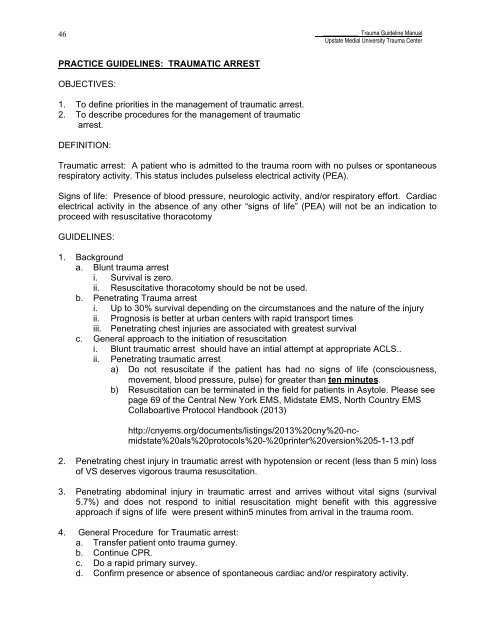Trauma Guideline Manual - SUNY Upstate Medical University
Trauma Guideline Manual - SUNY Upstate Medical University
Trauma Guideline Manual - SUNY Upstate Medical University
You also want an ePaper? Increase the reach of your titles
YUMPU automatically turns print PDFs into web optimized ePapers that Google loves.
46____________ <strong>Trauma</strong> <strong>Guideline</strong> <strong>Manual</strong><strong>Upstate</strong> Medial <strong>University</strong> <strong>Trauma</strong> CenterPRACTICE GUIDELINES: TRAUMATIC ARRESTOBJECTIVES:1. To define priorities in the management of traumatic arrest.2. To describe procedures for the management of traumaticarrest.DEFINITION:<strong>Trauma</strong>tic arrest: A patient who is admitted to the trauma room with no pulses or spontaneousrespiratory activity. This status includes pulseless electrical activity (PEA).Signs of life: Presence of blood pressure, neurologic activity, and/or respiratory effort. Cardiacelectrical activity in the absence of any other “signs of life” (PEA) will not be an indication toproceed with resuscitative thoracotomyGUIDELINES:1. Backgrounda. Blunt trauma arresti. Survival is zero.ii. Resuscitative thoracotomy should be not be used.b. Penetrating <strong>Trauma</strong> arresti. Up to 30% survival depending on the circumstances and the nature of the injuryii. Prognosis is better at urban centers with rapid transport timesiii. Penetrating chest injuries are associated with greatest survivalc. General approach to the initiation of resuscitationi. Blunt traumatic arrest should have an intial attempt at appropriate ACLS..ii. Penetrating traumatic arresta) Do not resuscitate if the patient has had no signs of life (consciousness,movement, blood pressure, pulse) for greater than ten minutes.b) Resuscitation can be terminated in the field for patients in Asytole. Please seepage 69 of the Central New York EMS, Midstate EMS, North Country EMSCollaboartive Protocol Handbook (2013)http://cnyems.org/documents/listings/2013%20cny%20-ncmidstate%20als%20protocols%20-%20printer%20version%205-1-13.pdf2. Penetrating chest injury in traumatic arrest with hypotension or recent (less than 5 min) lossof VS deserves vigorous trauma resuscitation.3. Penetrating abdominal injury in traumatic arrest and arrives without vital signs (survival5.7%) and does not respond to initial resuscitation might benefit with this aggressiveapproach if signs of life were present within5 minutes from arrival in the trauma room.4. General Procedure for <strong>Trauma</strong>tic arrest:a. Transfer patient onto trauma gurney.b. Continue CPR.c. Do a rapid primary survey.d. Confirm presence or absence of spontaneous cardiac and/or respiratory activity.
















